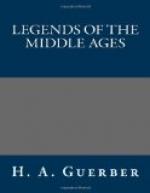“The nearest neighboring flood to Arthur’s ancient seat,
Which made the Britons’ name through all the world so great.
Like Camelot, what place was ever yet renown’d?
Where, as at Carlion, oft, he kept the Table-Round,
Most famous for the sports at Pentecost so long,
From whence all knightly deeds, and brave achievements sprong.”
DRAYTON,—Polyolbion.
[Sidenote: Knights of the Round Table.] Arthur had already warred successfully against twelve revolted kings, whose remains were interred at Camelot by his order. There Merlin erected a marvelous castle, containing a special hall for the reception of the Round Table. This hall was adorned with the lifelike statues of all the conquered kings, each holding a burning taper which the magician declared would burn brightly until the Holy Grail should appear. Hoping to bring that desirable event to pass, Arthur bade Merlin frame laws for the knights of the Round Table. As distinctive mark, each of the noblemen admitted to a seat at this marvelous table adopted some heraldic device. The number of these knights varies from twelve to several hundred, according to the different poets or romancers.
“The fellowshipp of the Table Round,
Soe famous in those dayes;
Whereatt a hundred noble knights
And thirty sat alwayes;
Who for their deeds and martiall feates,
As bookes done yett record,
Amongst all other nations
Wer feared through the world.”
Legend of King Arthur (Old Ballad).
Merlin, by virtue of his magic powers, easily selected the knights worthy to belong to this noble institution, and the Archbishop of Canterbury duly blessed them and the board around which they sat. All the places were soon filled except two; and as the knights arose from their seats after the first meal they noticed that their names were inscribed in letters of gold in the places they had occupied. But one of the empty seats was marked “Siege Perilous,” and could only be occupied by a peerless knight.
[Sidenote: Lancelot du Lac.]
Among all the knights of the Round Table, Sir Lancelot du Lac, who is the hero of several lengthy poems and romances bearing his name, was the most popular. Chrestien de Troyes, Geoffrey de Ligny, Robert de Borron, and Map have all written about him, and he was so well known that his name was given to one of the knaves on the playing cards invented at about this time. Malory, in his prose version of the “Morte d’Arthur,” has drawn principally from the poems treating of Lancelot, whose early life was somewhat extraordinary, too.
Some accounts relate that Lancelot was the son of King Ban and Helen. When he was but a babe, his parents were obliged to flee from their besieged castle in Brittany. Before they had gone far, the aged Ban, seeing his home in flames, sank dying to the ground. Helen, eager to minister to her husband, laid her baby boy down on the grass near a lake, and when she again turned around, she saw him in the arms of Vivian, the Lady of the Lake, who plunged with him into the waters.




